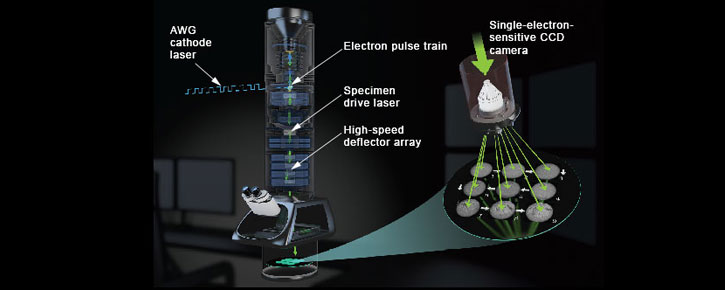Nanosecond-Imaging Microscope Reveals the Unseen
A blurred photograph results when a photo’s subject-matter changes while the camera’s aperture remains open. Similarly, transmission electron microscopy (TEM)—which shoots streams of electrons through thin slices of a specimen to reveal the specimen’s ultra-fine details—faces the challenge of capturing a crisp image at extremely high speeds and magnification. Since small-scale processes—such as the mechanisms of a virus infecting a cell—often happen at near-instantaneous speeds, researchers using TEM to discover the sequence of events in chemical reactions or biological processes must infer answers using before and after images. Thanks to LLNL’s expertise in lasers and microscopy, however, the novel Dynamic Transmission Electron Microscope (DTEM) has refined TEM’s temporal resolution by a factor of a million, a feat that promises to revolutionize the world of transmission electron microscopy.
The DTEM harnesses the precision of lasers to refine the spatial and temporal resolution of TEM. Ultraviolet light pulses from a laser and illuminates the microscope’s photocathode, which produces bursts of electrons. These electron pulses concentrate into a narrow beam as they are accelerated down the DTEM. When the electron beam passes through the sample, the scattering of the electrons creates an ultra-high resolution image of the sample that is captured on a detector—similar to a digital camera. What makes this process particularly valuable to scientists is that the laser pulses may be as brief as 10 billionths of a second—a trait that, as with a traditional high speed photograph, equates to sharper snapshots of time. This technology was enough to earn LLNL researchers an R&D 100 Award in 2008.

Determined to extend the impact of the single-shot DTEM, the Lab’s team added a high-speed deflector array to the microscope and developed an advanced laser system capable of producing precisely timed sequences of ultraviolet pulses. The deflector array sends the sample’s image to different regions of the digital receptor. By moving the deflector in time with the laser’s pulses, the DTEM technology can capture multiple, sequential, single-shot images with arbitrary temporal spacing. In short: the Dynamic Transmission Electron Microscope can make an ultrahigh-speed movie of the reactions occurring within the microscope’s chamber. Using this technology, researchers can capture sequential activities at the nanometer, 10 nanoseconds scale. This ability to visualize such fine-grain, high-speed reactions unlocks innumerable opportunities for scientists to examine the physical, biological, and chemical process that occur at near-instantaneous speeds. For this reason, the Lab’s DTEM-development team received another R&D 100 Award in 2013.
Daniel Masiel—founder and CEO of Integrated Dynamic Electron Solutions (IDES)—did his Ph.D. research with the LLNL DTEM group. The outstanding potential of the technology and the excitement it generated in the field inspired Dr. Masiel to commercialize this invention. After founding IDES in 2009, Dr. Masiel approached LLNL about acquiring the licenses for DTEM’s specialized technologies. Transforming the licenses into a wide array of manufactured Dynamic Transmission Electron Microscope products, IDES offers this advanced microscopy to the world. In 2011, IDES logged $1 million in sales, and in 2012, they received a Federal Laboratory Consortium Award for outstanding commercialization success. As DTEM’s abilities have expanded from single-shot images to movies, so have IDES’ products. IDES received a Small Business Innovation Research grant from the National Institute of Health to commercialize the LLNL-licensed Ponderomotive Phase Plate technology, which enhances biological imaging in DTEM. With this extended repertoire of products, two additional LLNL veterans—Thomas LaGrange and Bryan Reed—ultimately joined the IDES leadership.
Thanks to IDES’s continual dissemination of DTEM technology, these revolutionary instruments can now be found on three continents in R&D, basic science, and academic laboratories. The ongoing research and business partnerships formed between LLNL and IDES showcases the global impact that occurs when an outstanding research institution and a creative team of entrepreneurs work together to develop and spread ground-breaking technology around the world.

